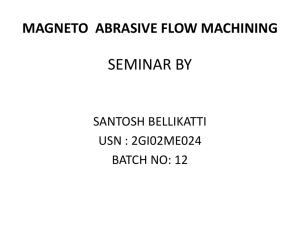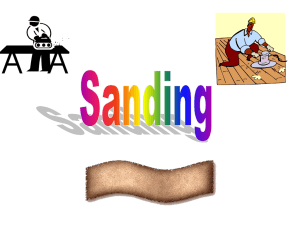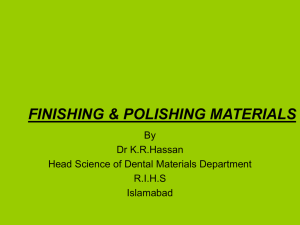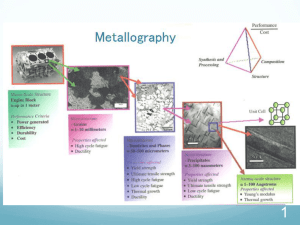Properties, structure and machnining capabilities sintered corundum
advertisement
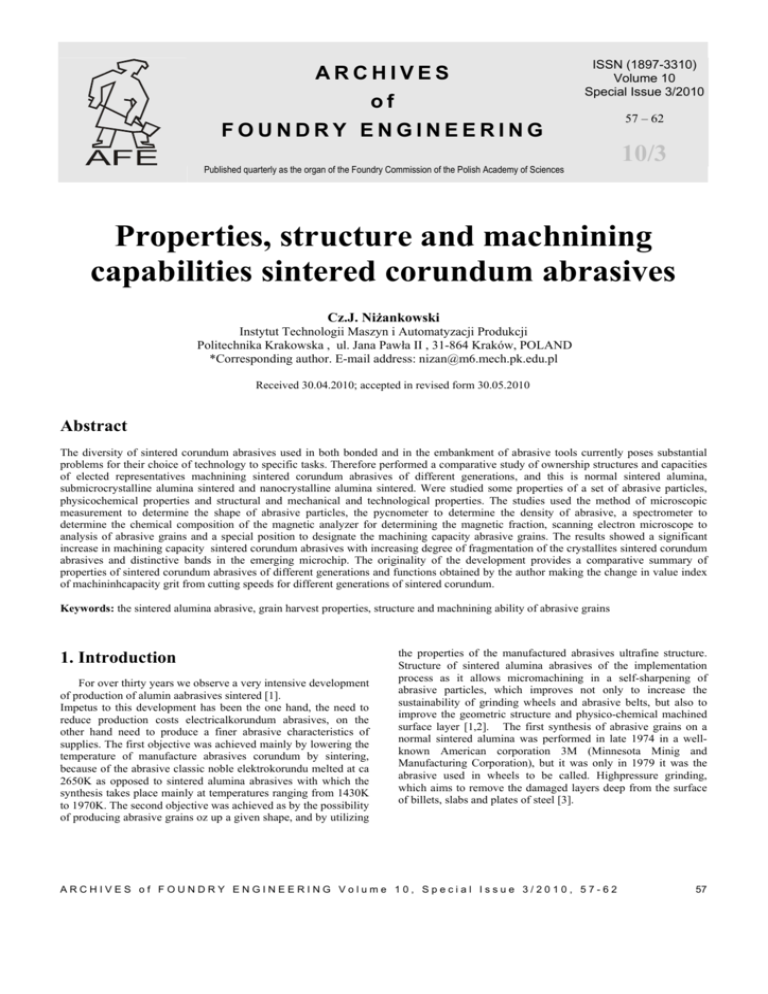
ARCHIVES of ISSN (1897-3310) Volume 10 Special Issue 3/2010 FOUNDRY ENGINEERING Published quarterly as the organ of the Foundry Commission of the Polish Academy of Sciences 57 – 62 10/3 Properties, structure and machnining capabilities sintered corundum abrasives Cz.J. Niżankowski Instytut Technologii Maszyn i Automatyzacji Produkcji Politechnika Krakowska , ul. Jana Pawła II , 31-864 Kraków, POLAND *Corresponding author. E-mail address: nizan@m6.mech.pk.edu.pl Received 30.04.2010; accepted in revised form 30.05.2010 Abstract The diversity of sintered corundum abrasives used in both bonded and in the embankment of abrasive tools currently poses substantial problems for their choice of technology to specific tasks. Therefore performed a comparative study of ownership structures and capacities of elected representatives machnining sintered corundum abrasives of different generations, and this is normal sintered alumina, submicrocrystalline alumina sintered and nanocrystalline alumina sintered. Were studied some properties of a set of abrasive particles, physicochemical properties and structural and mechanical and technological properties. The studies used the method of microscopic measurement to determine the shape of abrasive particles, the pycnometer to determine the density of abrasive, a spectrometer to determine the chemical composition of the magnetic analyzer for determining the magnetic fraction, scanning electron microscope to analysis of abrasive grains and a special position to designate the machining capacity abrasive grains. The results showed a significant increase in machining capacity sintered corundum abrasives with increasing degree of fragmentation of the crystallites sintered corundum abrasives and distinctive bands in the emerging microchip. The originality of the development provides a comparative summary of properties of sintered corundum abrasives of different generations and functions obtained by the author making the change in value index of machininhcapacity grit from cutting speeds for different generations of sintered corundum. Keywords: the sintered alumina abrasive, grain harvest properties, structure and machnining ability of abrasive grains 1. Introduction For over thirty years we observe a very intensive development of production of alumin aabrasives sintered [1]. Impetus to this development has been the one hand, the need to reduce production costs electricalkorundum abrasives, on the other hand need to produce a finer abrasive characteristics of supplies. The first objective was achieved mainly by lowering the temperature of manufacture abrasives corundum by sintering, because of the abrasive classic noble elektrokorundu melted at ca 2650K as opposed to sintered alumina abrasives with which the synthesis takes place mainly at temperatures ranging from 1430K to 1970K. The second objective was achieved as by the possibility of producing abrasive grains oz up a given shape, and by utilizing the properties of the manufactured abrasives ultrafine structure. Structure of sintered alumina abrasives of the implementation process as it allows micromachining in a self-sharpening of abrasive particles, which improves not only to increase the sustainability of grinding wheels and abrasive belts, but also to improve the geometric structure and physico-chemical machined surface layer [1,2]. The first synthesis of abrasive grains on a normal sintered alumina was performed in late 1974 in a wellknown American corporation 3M (Minnesota Minig and Manufacturing Corporation), but it was only in 1979 it was the abrasive used in wheels to be called. Highpressure grinding, which aims to remove the damaged layers deep from the surface of billets, slabs and plates of steel [3]. ARCHIVES of FOUNDRY ENGINEERING Volume 10, Special Issue 3/2010, 57-62 57 Fig. 1. General view of abrasive grain 76A of ordinary sintered alumina [2] In 1983, the same corporation conducted by sol-gel synthesis of the first alumina sintered submicrocrystalline, a trade name Cubitron (CB) Fig. 3. Exterior grit NanoWin (NW) with nanocrystalline alumina sintered [4] 2. Overview of experimental studies 2.1. Diagram of research and description of the factors Fig. 2. Exterior grit Cubitron (CB) with submikrokrystalicznego sintered alumina [1] However, the abrasive tools of this appeared abrasive tool on the market until after 1990. Area of their application was really impressive, from coarse to fine grinding [1,3]. In 2006, Rappold Austrian company announced that it has synthesized 'nanocrystalline' sintered alumina. In fact, the abrasive is produced with the characteristic dimension of crystallites of a few hundredths of meters [4], layer by chemical deposition from the gas phase chemical reactions involving the activation of the atmosphere by means of glow discharge, or by PACVD (Plasma Assisted Chemical Vapour Deposition). It is estimated that currently as many as six countries of the world (U.S., PRC, FR, Japan, Germany and Austria) are manufactured in sintered alumina abrasive in a full range of structural and that the size crystalline few μ meters, just a few tenths of a few hundredths of μ meters [ 4] 58 X-size of the input x1 - the size of crystallites in the sintered alumina abrasive grains (a species of grain) x2 - cutting speed (only for Z9) Z - output z1 - the shape of abrasive grains z2 - abrasive grain structure z3 - density abrasive z4 - the content of magnetic fraction z5 - abrasive ductility Z6 - chemical composition of the abrasive z7 - microhardness z8 - compressive strength z9 - the machining ability abrasive grains (the relative efficiency of grinding) C - constant volume c1 - sets of abrasive grains c2 - used equipment for measuring and testing c3 - the application of research methods and techniques H- size interfering (Eg, crystallite size dispersion) ARCHIVES of FOUNDRY ENGINEERING Volume 10, Special Issue 3/2010, 57-62 2.2. Research Methodology 3. Test results The study was conducted according to the elemental, the static, deterministic, complete plan experience (PSDK) without repetition of individual systems of the plan, due to the high cost of effort and research. Adopted the following levels of the input x1: The obtained experimental results are presented below in the form of histograms. 1) x1 = 0,02 ± 0,01 μm 2) x1 = 0,2 ± 0,1 μm 3) x1 = 2 ± 1 μm (NW) (CB) (76A) The ability of abrasive grains sliced determined by the relative performance micromachining. Z= GS % GM (1) Where : Gm- Chip load Gs - weight loss grit 2.3. Tech Research The study used abrasive type 76A, and Cubitron NanoWin 24th seed numbers The shapes of abrasive grains have been determined by measuring the size of bulky microscope at a special m.μworkshop with an accuracy of 1 Abrasive grain structure studied was observed on a JEOL JSM scanning electron microscope type LV-5510 coupled with the desktop computer. Densities were determined using abrasives pycnometer in a traditional way. The content of magnetic fraction was determined using a magnetic analyzer production of the USSR. However, ductility abrasive resistance was determined by a special grinding ball mill followed by sieving on sieves FRITSCH GmbH. Chemical compositions of tested abrasives determined using Xray spectrometer, and was determined by Vickers microhardness. The compressive strength determined on the hydraulic press using a special device made in CP. Capacity indicator machining abrasive grains determined by formulas (1) referring machining weight material (microchip) for weight loss abrasive material after from the socket smelting honing. Fig. 4. General view of the position to determine the ability of abrasive grains machining Fig. 5. Comparison of grain shape indices Fig. 6. Microstructure grit 76A alumina sintered ordinary (pow.2000x) Fig. 7. Microstructure grit 76A alumina sintered ordinary (pow.10000x) ARCHIVES of FOUNDRY ENGINEERING Volume 10, Special Issue 3/2010, 53-56 59 Fig.11. Comparison of the density tested abrasives Table 1. Fig. 8. Microstructure grit Cubitron (CB) from s submicrocrystalline sintered corundum (pow.2000x) Photo microstructure grit NanoWin (NW) is not given in the paper due to the fact that, with the greatest magnification scanning electron microscope could see only a black background with gray points. Fig. 9. Microstructure abrasive grain Cubitron (CB) of alumina submicrocrystalline Sintered (pow.10000x) Fig. 10. Comparison of density tested abrasives 60 Comparison of chemical compositions investigated abrasives. Compound 76A CB NW Symbol % mass % mass % mass Al2O3 87,5 94,5 98,0 ZrO2 -------Scanty Scanty TiO2 3,5 Scanty Scanty SiO2 4,0 ------------Fe2O3 4,5 1,5 0,6 MgO -------3,4 1,3 CaO Scanty Scanty -------- Fig.12. Comparison of toughness tested abrasives Fig.13. Comparison of microhardness test of abrasive grains ARCHIVES of FOUNDRY ENGINEERING Volume 10, Special Issue 3/2010, 57-62 Fig.14. Comparison of compressive strength abrasives tested The ability of abrasive grains machining respondents identified in the process of turning toughened to the hardness of HRC 42 ± conical cylinders of alloy steel construction, designed specifically for the manufacture of the equipment loaded. As the blades of cutting tools used abrasive grain abrasive test soldered on the frame honing onegrain flange (after checking the angles of corners). Carried out on a high speed turning, precision lathe with stepless speed control spindle. Cutting speed varied from 4 to 10 m/s at 2 m/s. Microchipmass and weight loss cutting abrasive grains (after smelting ) was measured using laboratory balance. Fig.15. Comparison of the capacity of machined respondents abrasive grains according to the speed micromachining Fig.16. Comparison of the machining ability respondents abrasive grains according to the speed micromachining On the basis of experimental results determined following function test objects: • the machining ability grit 76A alumina sintered ordinary Z = 149 + 9.75 vc (2) With a coefficient of determination R2 = 0,9657 (3) the ability to grit machining CB Z = 158,5 +11,5 vc (4) With a coefficient of determination (5) R2 = 0,9921 the ability to grit machining NW Z = 135.7 + 19.15 Vc (6 With a coefficient of determination R2 = 0,9937 (7) Fig.17. Chips obtained by micromachining sintered corundum grains in the process of rolling ARCHIVES of FOUNDRY ENGINEERING Volume 10, Special Issue 3/2010, 53-56 61 Characteristic bands on the surface of the chip flow traces of the many submicroedges (crystallite ) sintered alumina abrasive particles. 4. Conclusion The results of experimental studies permit the following conclusions: • together with the reduction of crystallite size of abrasive grains of alumina sintered getting better all the properties of abrasive grains, • differences in the shapes of abrasive grains examined and small differences in their chemical compositions resulting from the manufacturing technology, • the ability to spark sintered alumina abrasive particles increases with cutting speed. This increase is all the more intense their magnitude crystallites forming the structure of the grains is lower. Therefore NanoWin abrasive type is preferably used only at high cutting speeds 62 References [1] Niżankowski Cz. ,Badania właściwości ściernic typu Cubitron 3M. Podstawy i technika obróbki ściernej. Wyd. WSI Ksz.,Koszalin 1993 str.17-22. [2] Niżankowski Cz.,Właściwości skrawne ściernic z korundu spiekanego. Monografia 205.Zakł.Graf.PK , Kraków 1996. [3] Staniewicz – Brudnik B.Wodnicka K.,Jaworska Wl.,The effect of the high energetic milling polymorphic Changes of submikrocrystaline korundum grains Współczesne problemy obróbki Wyd.Ucz. PKSz., Koszalin 2009 str 43-52. L.,Wilk on the sintered ściernej. [4] Katalogi firmy Rappold 2008. ARCHIVES of FOUNDRY ENGINEERING Volume 10, Special Issue 3/2010, 57-62
